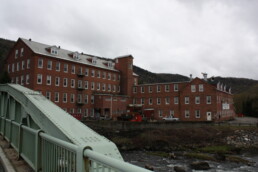Many people are now aware of the dangers of asbestos and how it has caused tens of thousands of workers on construction sites, in paper mills, in many trades (including plumbers, pipefitters, and mechanics), and even Navy veterans, to develop mesothelioma. Mesothelioma is caused when microscopic asbestos dust and fibers are breathed into the lungs, causing irritation and scarring that damages the lungs and pleura over time, taking up to 50 years after initial exposure to develop into a cancer and show symptoms.
Aside from workplace exposure, there is also potential for asbestos exposure in your own home. The danger is especially prevalent in older homes built before 1980. As home prices increase and it becomes harder for first-time home buyers to afford a newer house, buyers are increasingly turning to older “fixer-uppers,” intending to renovate. Unfortunately, many of these older homes were built before the widespread use of asbestos was stopped. In many cases, asbestos was used because of its durability, heat resistance, and fire resistance. If your home was built before 1980, it’s possible that some of its components contain asbestos and we caution you to do your research before beginning any renovation projects that involve:
- demolition
- sanding
- drilling
- grinding
- sawing
- hammering
- boiler or pipe removal
These activities will surely disturb any asbestos within your home and release potentially deadly dust and fibers into the air.
Don’t Renovate Until You Test For Asbestos
It doesn’t matter how much was used, if asbestos is present in any amount, it poses a danger. If you suspect the presence of asbestos, do not disturb it and seal off the area, if possible. The best way to know for sure if asbestos is present is to have a sample of the suspicious product tested.
Below we outline some of the most common places you might find asbestos in your older home. If you have plans to renovate any of these areas we urge you to take the necessary precautions and to contact a professional to help remove the asbestos and remediate the site.
Asbestos in The Ceiling
The dreaded “popcorn” ceiling and suspended ceilings are the worst offenders. Popcorn ceilings, popular from the 1950s to the 1980s, were often made with vermiculite, a material that regularly contained asbestos. This is the stuff that gives the ceiling its telltale rough and bumpy texture. Do not attempt to remove this material yourself!
Suspended ceilings, using individual tiles suspended within a frame, were often used in kitchens and basements to cover up unsightly ductwork and one of the most common materials used for these tiles was asbestos. Some estimates say that 5% to 10% of ceiling tiles in the US contain asbestos.
If you know the company that manufactured your tiles, you can check to see whether they did, in fact, use asbestos in their process, but this information is often not readily available. If you don’t have this information available, there are some clues to look for: most old asbestos ceiling tiles look light colored, slightly textured and powdery white, often with small dotted indentations. If you look on the back of the tile and it’s a salmon color, those particular tiles are also asbestos-containing.
Asbestos in The Floor
Vinyl floor tiles, sheet flooring, or linoleum sheet flooring were used extensively in homes constructed before the 1980s because of their durability, most often in kitchens, entryways, mudrooms, bathrooms, and finished basements. Many of today’s homeowners are opting for wood, tile, or luxury vinyl plank flooring. If you’re looking to change up your vinyl floors, be sure to find out if they contain asbestos before replacing them. In addition to their age, you can use the following clues to help identify hazardous material:
- Size: A bit thicker than modern vinyl tiles, the most common size for asbestos-containing vinyl floor tiles was 9″ x 9″, but they also came in 12″ x 12″ and 18″ x 18″.
- Color and pattern: Asbestos vinyl tiles were most often light blue, cream, pink, or green, while the most popular colors for asbestos vinyl sheet flooring were white, blue, and brown. They were often designed to look like carpeting, stone, or wood flooring.
- Stains: Many asbestos flooring was made with asphalt and over time, the oils from the asphalt leaks out, causing discoloration and fading.
- Adhesive backing: Thick black flooring adhesive underneath the tiles can also indicate the presence of asbestos. Linoleum and vinyl sheet flooring could also contain asbestos backing in the form of black tar paper or felt paper. Although the sheet itself doesn’t contain asbestos, the backing that serves as a cushion can contain high asbestos concentrations.
If you’re in the market to replace your older vinyl floors, be sure to have them tested before you start. Alternatively, you could choose to put a floor on top of them, leaving the old contaminated flooring in place, sealed off and undisturbed.
Asbestos in The Walls
After moving into your older home (and maybe after watching a few hours of HGTV) you may feel the urge to grab your sledgehammer and start the demo. STOP! You need to be mindful of the age of your home and whether you should be tearing down walls without a proper plan in place that protects you and your family from asbestos.
Drywall installed before 1980 might have used asbestos-containing joint compound to hide the seams and screws between the panels. Asbestos was often added to plaster – if your walls are labeled “fire-rated,” they definitely contain asbestos. Find out if your walls were produced by these common manufacturers of contaminated plaster walls. It is very important that you contain any dust created during the removal of these walls. We encourage you to hire a professional to determine if you can safely proceed!
Asbestos in The Basement
Many older homes have a boiler in the basement and it’s safe to say that any boiler installed before 1980 probably contains asbestos, especially if your boiler looks like a “snowman.” These cast iron snowman boilers—so called because they were short and round and covered with several inches of thick asbestos insulation—require special remediation companies to dispose of. The “jacketed” boiler, which is the type most people have, looks like a square or rectangle with a metal jacket on the outside and may not look like it has any asbestos in it, but, depending on the age of the boiler, the insulation behind that jacketing that could be asbestos. Any older boiler, whether snowman or jacketed, could also have asbestos insulation on the pipes: if you see a chalky white covering on your pipes, don’t touch it, don’t bang it, and make sure that, if it does turn out to be asbestos, it is handled properly before the rest of the boiler is replaced.
Asbestos in The Attic
If your old attic contains insulation made of cellulite or fiberglass, there is nothing for you to worry about. However, some old houses, especially those located close to vermiculite plants like those operated by WR Grace in Northampton in western Massachusetts, used a type of insulation made of vermiculite which, while not technically asbestos, is often contaminated with it. You can recognize this type of insulation by sight. Small, granular, and pebble-like material that resembles coarse sand, it is light and fluffy, and tan or light brown in color. It was typically blown into attics right on top of the ceiling in between the joists, and is especially vulnerable to being disturbed. Be sure to call a professional to remove this type of insulation.
Call Us For Help
If you or a loved one has worked on old houses in the past—whether as a DIY project or as your profession—and have developed mesothelioma, call us for a free consultation about whether you may be entitled to compensation. We take the time to explain the process from beginning to end, setting realistic expectations and timelines. If you are unable to come to our offices due to health or other reasons, we will come to you to listen to your story and tell you honestly if we think you have a viable claim. We have helped hundreds of individuals and families obtain justice for their injuries, regularly obtaining settlements and verdicts in the millions. And you will never pay unless we deliver results for you.








